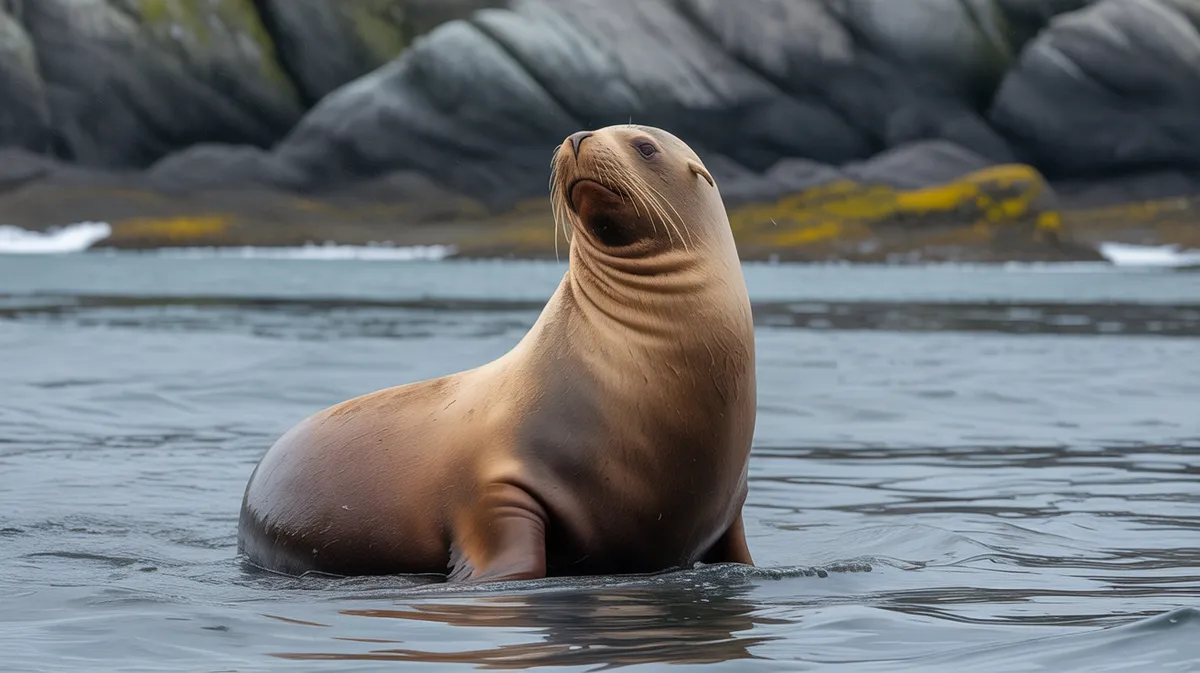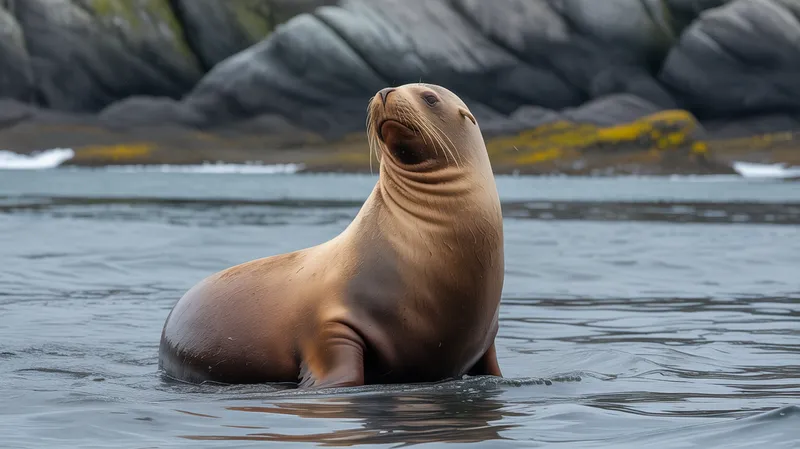
Steller Sea Lion
Eumetopias jubatus

Meet the Steller Sea Lion
The Steller sea lion, also known as the northern sea lion, is the largest member of the Otariidae (eared seal) family. Males can weigh up to three times as much as females and are known for their thick necks and impressive manes. Steller sea lions inhabit the cold, temperate coastal waters of the North Pacific, often hauling out in large groups on rocky shores or isolated islands. Their loud vocalizations and social behaviors are distinctive, especially during breeding season. Despite their size, they are agile swimmers and skilled hunters, preying on a variety of fish and cephalopods.
Classification
Mammal
Habitat
Coastal marine environments and rocky shores
Diet
Carnivore
Lifespan
15-30 years
Conservation
Near Threatened
Weight
240–1,120 kg (530–2,470 lbs)
📖Fascinating Facts
Largest Eared Seal
Steller sea lions are the largest species in the Otariidae family, with males sometimes exceeding 1,000 kg (2,200 lbs).
Deep Divers
They are capable of diving over 400 meters (1,300 feet) deep and can stay submerged for up to 16 minutes to hunt fish and squid.
Ears and Mobility
Unlike true seals, Steller sea lions have external ear flaps and use their powerful front flippers to move efficiently on land.
📋Detailed Description
The Steller sea lion (Eumetopias jubatus) is the largest member of the Otariidae family, with adult males (bulls) reaching lengths of 2.8–3.3 meters (9.2–10.8 ft) and weighing 600–1,120 kg (1,320–2,470 lbs), while females (cows) are significantly smaller at 2.3–2.9 meters (7.5–9.5 ft) and 240–350 kg (530–770 lbs). Bulls are characterized by their massive, muscular necks and a thick mane of coarse hair, which distinguishes them from the sleeker females. Their fur is pale to tawny brown, often appearing lighter when dry. Steller sea lions possess external ear flaps and large, wing-like foreflippers, adaptations that make them agile swimmers capable of reaching speeds up to 27 km/h (17 mph). They are highly social, forming large colonies on remote rookeries and haul-out sites, where complex social hierarchies are established, especially during the breeding season. Their vocal repertoire includes deep roars, growls, and barks, used for communication and territorial displays. Steller sea lions are opportunistic predators, feeding on over 100 species of fish and cephalopods, and are known for their cooperative hunting strategies. Their life expectancy in the wild is typically 15–20 years, though some individuals have been documented living over 30 years. Anatomically, they exhibit sexual dimorphism, with males developing pronounced sagittal crests and larger canines, features linked to intraspecific competition. Their robust physiology enables them to dive to depths exceeding 400 meters (1,300 ft) and remain submerged for up to 16 minutes, though most foraging dives are much shallower and shorter.
💡 Did you know?
Despite their bulk, Steller sea lions can dive to depths of over 400 meters (1,300 feet) when hunting for food.
🔬Research & Sources
Wikipedia Summary
The Steller sea lion, also known as Steller's sea lion or the northern sea lion, is a large, near-threatened species of sea lion, predominantly found in the coastal marine habitats of the northeast Pacific Ocean and the Pacific Northwest regions of North America, from north-central California to Oregon, Washington and British Columbia to Alaska. Its range continues across the Northern Pacific and the Aleutian Islands, all the way to Kamchatka, Magadan Oblast, and the Sea of Okhotsk, south to Honshu's northern coastline. It is the sole member of the genus Eumetopias, and the largest of the so-called eared seals (Otariidae). Among pinnipeds, only the walrus and the two species of elephant seal are bigger. The species is named for the naturalist and explorer Georg Wilhelm Steller, who first described them in 1741. Steller sea lions have attracted considerable attention in recent decades, both from scientists and the general public, due to significant declines in their numbers over an extensive portion of their northern range, notably in Alaska.
Last Modified: 5/17/2025
🎭Behavior & Social Structure
Steller sea lions display a range of complex social behaviors, particularly evident in their large, dense colonies. Outside the breeding season, they haul out in mixed-sex groups, engaging in social grooming, play, and vocal exchanges. During the breeding season, males establish and defend territories through vocalizations, posturing, and occasional physical confrontations. They are primarily diurnal, with peak activity during dawn and dusk when foraging occurs. Their diet is highly varied, including walleye pollock, Pacific cod, herring, salmon, squid, and octopus. Steller sea lions employ both solitary and group hunting tactics, sometimes herding fish into tight schools for efficient capture. They are known to exhibit site fidelity, returning to the same haul-out and rookery sites annually. Resting and thermoregulation are achieved by hauling out on land or floating in 'rafts' at the water's surface. Social bonds are especially strong between mothers and pups, with vocal recognition playing a key role in reunification after foraging trips.
👶Reproduction & Life Cycle
Breeding occurs from late May to early July, with males arriving first to establish territories on rookeries. Bulls may fast for several weeks while defending their harems, which can consist of up to 20 females, though the average is smaller. Females give birth to a single pup after a gestation period of approximately 11.5 months, which includes a delayed implantation of the embryo for several months. Pups are born weighing 18–22 kg (40–48 lbs) and are able to swim within a few weeks, though they remain on land for the first month. Maternal care is intensive; mothers alternate between nursing on land and foraging at sea, relying on vocal and olfactory cues to locate their pups upon return. Weaning typically occurs at 12–24 months, but some pups may nurse for up to three years. Sexual maturity is reached at 3–6 years for females and 5–8 years for males, though few males successfully breed before age 9 due to intense competition.
🛡️Adaptations & Survival
Steller sea lions possess several adaptations for their marine lifestyle. Their streamlined bodies and large, powerful foreflippers enable efficient propulsion and maneuverability underwater. A thick layer of blubber provides insulation in cold waters and serves as an energy reserve during fasting. Their large eyes are adapted for low-light vision, aiding in deep or nocturnal foraging. Vibrissae (whiskers) are highly sensitive, detecting vibrations and movements of prey. The ability to slow their heart rate (bradycardia) during dives conserves oxygen, allowing extended submersion. Social adaptations include complex vocalizations and strong mother-pup recognition systems. Males develop secondary sexual characteristics, such as enlarged neck muscles and sagittal crests, which are advantageous in male-male competition for mates.
📚Research Sources
🎨Cultural Significance
Steller sea lions hold cultural and subsistence importance for Indigenous peoples of the North Pacific, who have traditionally hunted them for meat, oil, and hides. In folklore and mythology, they are often depicted as powerful and intelligent marine beings. Their presence in coastal ecosystems is also valued for ecotourism and wildlife observation. In modern times, they have become symbols of marine conservation, representing the challenges of balancing human activities with ecosystem health.
🔬Recent Research & Discoveries
Recent research has focused on the causes of population decline, including nutritional stress hypotheses, disease prevalence, and the impact of environmental variability. Genetic studies have revealed distinct eastern and western populations, with limited gene flow between them. Satellite telemetry and biologging have provided detailed insights into foraging ranges, dive behavior, and habitat use. Studies on maternal investment and pup development have advanced understanding of pinniped reproductive strategies. Ongoing monitoring by NOAA and other organizations employs aerial surveys, remote cameras, and acoustic monitoring to track population trends and distribution. The fossil record, including Pleistocene specimens, has helped clarify the species' evolutionary history and biogeography.
🎥Wildlife Videos

Wonders of the Wild: The Steller Sea Lion (full documentary)
Early 90's Discovery Channel VHS rip.
Forgotten Documentaries

The Sea Lion King - An Epic Adventure | Free Documentary History
The Sea Lion King - An Epic Adventure | Ocean Documentary Watch 'Adventure Ocean Quest - Unveiling the Secrets of the ...
Free Documentary - Nature

Sea Lion's Wild Nature National Geographic Documentary// Lions of the Deep
Lions of the Deep | Wildlife Documentary Since the 1970's, sea lion populations have declined more than 80% along the North ...
The Animal Adventures

Saving Canada's Stellar Sea Lion From Extinction | The Blue Realm | Real Wild
Since the 1970's, sea lion populations have declined more than 80% along the North Pacific coast. Scientists at the University of ...
Real Wild

These Steller Sea Lions Are in HEAVEN!
The Steller Sea Lion looks similar to its California cousin but is actually 3 times larger! These grizzly bears of the sea prefer ...
AquaTerra

Disneynature’s Sea Lions of the Galápagos | Official Trailer
Meet Leo in Disneynature's "Sea Lions of the Galápagos", narrated by Brendan Fraser! Available only on @DisneyPlus April 22.
Disney Plus
🌍Habitat Information
The Steller Sea Lion typically inhabits Coastal marine environments and rocky shores environments. Steller Sea Lions have adapted to their environments with specialized features and behaviors.
Primary Habitat:
Coastal marine environments and rocky shores
More detailed habitat information will be available soon.
🛡️Conservation Status
The Steller Sea Lion is currently classified as Near Threatened. Conservation efforts are crucial for preserving this species for future generations.
Common Threats:
- 🏠Habitat loss and fragmentation
- 🌡️Climate change impacts
- 🎯Hunting and poaching
- 🏭Human-wildlife conflict
⚠️Threats & Conservation Challenges
Steller sea lions have experienced significant population declines, particularly in the western portion of their range (notably the Aleutian Islands and Gulf of Alaska), leading to their classification as Near Threatened by the IUCN. Major threats include entanglement in fishing gear, competition with commercial fisheries for prey species, illegal shooting, and habitat disturbance from human activities. Environmental changes, such as ocean warming, reduced prey availability, and increased frequency of harmful algal blooms, also pose significant risks. Predation by killer whales and, to a lesser extent, sharks and large terrestrial carnivores, affects pup and juvenile survival. Conservation efforts focus on fishery management, habitat protection, and monitoring of population trends, but recovery in some regions remains slow and uncertain.
🔬Scientific Classification
Scientific Name
Eumetopias jubatus
Classification Hierarchy
🔍 About Taxonomic Classification
Taxonomic classification is a hierarchical system used by scientists to classify and organize living organisms based on shared characteristics and evolutionary relationships.
The system moves from broad categories (Kingdom) to increasingly specific ones, with each animal's scientific name typically consisting of its Genus and species.
📝Community Notes
Share your observations and insights about the Steller Sea Lion with our community of wildlife enthusiasts.
Join Our Community
Sign in to share your observations and connect with fellow wildlife enthusiasts.
Sign In to ContributeNo community notes yet
Be the first to share your observations about the Steller Sea Lion!
Explore Steller Sea Lion
Select a tab above to learn more about this amazing animal.
📸Photo Gallery
No photos available for this animal yet.
🌟Discover More Wildlife
Continue your journey of discovery with more fascinating animals from our database
